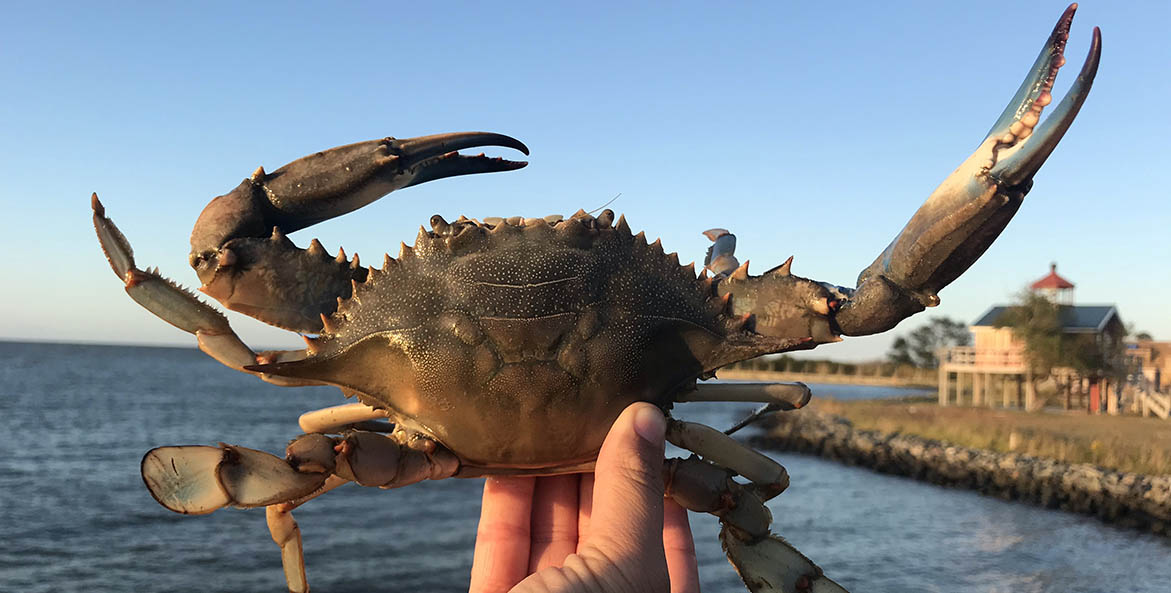Late last month, the annual survey about one of the Bay’s most beloved critters was released. The annual blue crab winter dredge survey—an estimate of the population of blue crabs in the Chesapeake Bay and its tributaries—had mixed results. While it showed some signs of improvement, concerns remain about the overall decline in blue crabs (AKA Callinectes sapidus or the Atlantic blue crab).
The survey, which the Virginia Marine Resources Commission (VMRC) and Maryland Department of Natural Resources (DNR) conduct each year, estimated total crab abundance at 317 million blue crabs, a slight decline from last year’s survey results.
While an improvement over the 2022 blue crab survey, which showed the lowest level on record in the survey’s then 33-year history, this year’s survey is concerning, particularly for juvenile crabs. That segment of the population has remained well below the survey’s long-term average for five consecutive years—a figure that paints a bleak picture for a healthy population and sustainable harvest in the Chesapeake Bay.
“The results of this year’s survey are less than hoped for given the importance of blue crabs in the Chesapeake Bay region,” says CBF’s Virginia Executive Director Chris Moore. “The continued low numbers of adult females and males underscores the need to protect these segments of the population.”
Maine Blue Crabs?
Meanwhile our friends to the north are starting to see our blue crabs more and more in their own backyard—the Gulf of Maine. This body of water is one of the fastest warming on the planet, making it more hospitable to the Bay’s blue crabs. Over the past few years, blue crabs have been observed in these waters in increasing numbers, as reported by researchers, harvesters, and beachgoers.
While the northward expansion of the blue crab may be a welcome sign to some economically with the possibility of a new fishery on the horizon, environmentally, these blue crabs may cause disruption to marine communities, including Maine’s foundational fishery—the lobster. “Blue crabs are one of the most aggressive crab species and pose predatory and habitat threats to lobsters,” said Aaron Whitman, a senior research associate at the Gulf of Maine Research Institute in Portland.
That said, these sightings in Maine may be a fleeting phenomenon for now. “The presence of blue crabs in the Northeast, including Maine, is likely related to range shift due to climate change and changing ocean circulation, which carries blue crab larvae to estuaries further north,” says CBF’s Maryland Executive Director Allison Colden. “For the time being, most think that these populations are ephemeral as wintertime temperatures still dip low enough to cause high crab mortality.”
Atlantic Blue Crabs Abroad
In yet another (and even more surprising) part of the world, blue crabs are on the rise. Across the Atlantic, parts of France, Croatia, and Italy (among other European countries), are grappling with a surge in blue crabs, which are considered invasive in the region. “They do not have native predators and are proliferating rapidly there, similar to blue catfish in the Chesapeake Bay,” says Colden.
How they found their way 5,000 miles across the ocean is anyone’s guess, but it likely involved hitching a ride in the ballast water of cargo ships. Once established in the Mediterranean and its tributaries like the Po River, the blue crab is feasting on native clams, mussels, and other shellfish, and wreaking havoc on the fishing industry in the process. An oyster farmer in the lagoon of Leucate in the south of France went as far as to call them “serial killers,” attacking anything that swims or crawls.
We may not share that exact sentiment about one of our favorite (and tasty) critters. The blue crab remains not only the most iconic but also one of the most economically important fisheries to the Chesapeake Bay region.
Colden says: “While fisheries in the Bay might be struggling, fishermen in Europe are looking to harvest to control the growing blue crab population and offset their financial losses. If imported blue crabs start to fill the gap in the blue crab market in the U.S., there could be further impacts to Bay watermen who would otherwise harvest crabs from the Bay.”
What Can We Do for Blue Crabs in the Chesapeake?
Back in the Chesapeake, on the heels of the recent crab survey results, VMRC just opened the door to a controversial reopening of the winter crab harvest June 25, ending a 15-year harvest closure and going against the guidance of multiple scientific advisors, including the commission's own staff. This decision represents a major breakdown in the cooperative management of blue crabs across the Chesapeake Bay and will have adverse impacts on one of our most iconic and economically important fisheries. It's more than clear to us that we must demand more from our leaders.
Climate change, predators like the invasive blue catfish, weather, and the loss of underwater grasses all contribute to fluctuating numbers of blue crabs. Controls on the blue crab fishery are only one part of the formula for restoring the crab population. Wise management of predators such as blue catfish and improvements in water quality are vitally important to ensuring both a sustainable blue crab population and fishery in the future.




